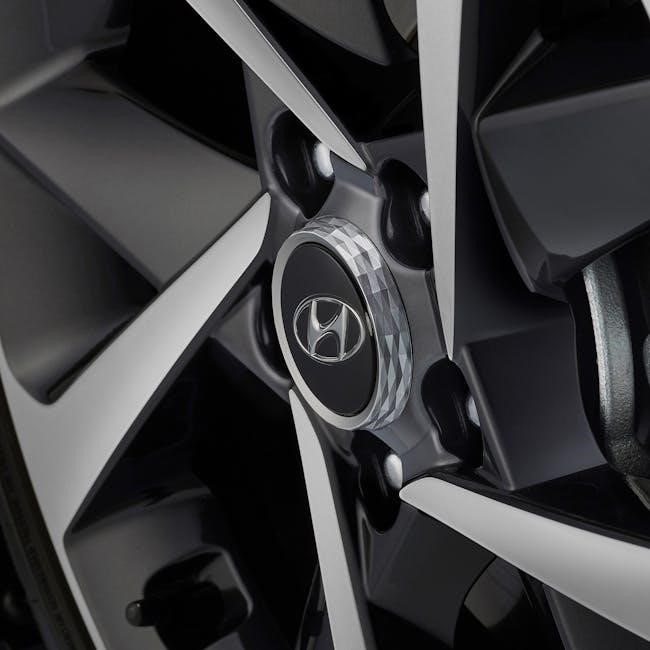
hyundai fault codes pdf
Hyundai fault codes are diagnostic tools indicating specific issues in vehicles․ They include generic and manufacturer-specific codes, helping identify problems efficiently․ A detailed guide is available in the hyundai-error-codes․pdf document, aiding in effective troubleshooting and repairs․
What Are Hyundai Fault Codes?
Hyundai fault codes are alphanumeric codes generated by the vehicle’s onboard diagnostic (OBD) system to indicate specific issues․ These codes, such as P0014 or P0131, are structured to provide clear information about malfunctions in sensors, actuators, or engine components․ They are categorized into generic (P0) and manufacturer-specific (P1) codes, offering detailed insights for technicians and drivers․ By referencing the hyundai-error-codes․pdf, users can decode these signals, enabling efficient troubleshooting and repairs of their Hyundai vehicles․
Importance of Understanding Fault Codes
Understanding Hyundai fault codes is crucial for identifying and resolving vehicle issues promptly․ These codes serve as a communication tool between the car and driver, signaling malfunctions in sensors, actuators, or engine components․ By decoding them, drivers can address problems early, preventing further damage and costly repairs․ Regular diagnostics using these codes ensure vehicle health and reliability․ Referencing resources like the hyundai-error-codes․pdf guide provides detailed insights, empowering owners to maintain their vehicles effectively․

How to Retrieve Hyundai Fault Codes
Use an OBD-II scanner to retrieve Hyundai fault codes by connecting it to the OBD-2 port under the dashboard․ Refer to the hyundai-error-codes․pdf for guidance․

Using an OBD-II Scanner
To retrieve Hyundai fault codes, turn off the ignition and connect an OBD-II scanner to the OBD-2 port under the dashboard on the driver’s side․ Ensure the ignition is off before connecting the scanner․ Once connected, turn the ignition to the “ON” position but do not start the engine․ The scanner will communicate with the vehicle’s ECU to retrieve stored codes․ Both generic and manufacturer-specific codes can be retrieved this way․ Refer to the hyundai-error-codes․pdf guide for detailed instructions and code interpretations․
Connecting to the OBD-2 Port
The OBD-2 port is typically located under the dashboard on the driver’s side of Hyundai vehicles․ To connect, turn off the ignition and locate the 16-pin OBD-2 connector․ Plug in the OBD-II scanner or compatible tool, ensuring a secure connection․ Turn the ignition to the “ON” position (do not start the engine) to power the system․ The scanner will then communicate with the vehicle’s ECU to retrieve fault codes․ Ensure compatibility with Hyundai-specific codes for accurate results, as outlined in the hyundai-error-codes․pdf guide․
Common Hyundai Fault Codes
Hyundai vehicles often display codes like P0014 (crankshaft/camshaft correlation) and P0131 (HO2S sensor low voltage)․ These codes help diagnose issues such as sensor malfunctions or mechanical faults, as detailed in the hyundai-error-codes․pdf guide․
P0014 — Crankshaft Position Camshaft Position Correlation
The P0014 code indicates a correlation issue between the crankshaft and camshaft positions․ This fault often occurs when there’s a timing mismatch, potentially caused by worn timing components or faulty sensors․ Symptoms may include rough engine idling, reduced power, or stalling․ Addressing this issue promptly is crucial to prevent further damage․ The hyundai-error-codes․pdf guide provides detailed troubleshooting steps and repair recommendations for resolving this common Hyundai fault code effectively․
P0131, HO2S Sensor Circuit Out of Range Low Voltage
The P0131 code points to a low voltage issue in the HO2S (Heated Oxygen) sensor circuit․ This sensor monitors oxygen levels in exhaust gases․ Contamination from water or fuel can trigger this fault․ Symptoms include decreased fuel efficiency and engine performance issues․ The hyundai-error-codes․pdf document outlines diagnostic steps, such as checking sensor wiring and connections, to identify and resolve the problem effectively, ensuring proper engine operation and fuel efficiency․

Interpreting Hyundai Fault Codes
Hyundai fault codes are alphanumeric, providing detailed insights into vehicle issues․ The hyundai-error-codes․pdf guide explains code structures, helping technicians understand each component’s meaning and identify faults accurately for effective repairs․
Structure of Hyundai Fault Codes
Hyundai fault codes follow a specific alphanumeric format, typically consisting of letters and numbers․ The initial letters indicate the system affected, while the numbers identify the specific issue․ For example, “P” codes relate to powertrain issues, while “B” codes pertain to body systems․ The hyundai-error-codes․pdf guide provides a detailed breakdown, explaining each code’s structure and meaning․ This standardized format allows technicians to quickly identify and address problems, streamlining the diagnostic process for efficient repairs and maintenance․
Understanding Code Meanings
Understanding Hyundai fault codes is crucial for effective diagnostics․ These codes are alphanumeric, combining letters and numbers to specify issues․ Generic codes, like P0131, are standardized, while manufacturer-specific codes, such as B1644, are unique to Hyundai․ The hyundai-error-codes․pdf guide provides detailed explanations, breaking down each code’s meaning․ By deciphering these codes, technicians can quickly identify affected systems and components, enabling precise repairs․ This understanding is essential for resolving issues efficiently and ensuring vehicle reliability, as outlined in the comprehensive PDF resource․
Diagnosing Issues Using Fault Codes
Hyundai fault codes help identify vehicle issues efficiently․ By referencing the hyundai-error-codes․pdf, technicians can diagnose problems accurately, ensuring timely and effective repairs․
Identifying the Root Cause
Hyundai fault codes simplify diagnosing by pinpointing specific issues․ For example, P0014 indicates a crankshaft and camshaft position correlation problem, while P0131 points to an oxygen sensor issue․ By referencing the hyundai-error-codes․pdf, technicians can decode each code, identify affected components, and trace the root cause․ This structured approach ensures accurate troubleshooting, reducing guesswork and saving time․ Manufacturer-specific codes, like B1644 for airbag systems, further aid in precise diagnoses, making repairs more efficient and reliable․ Regular code checks prevent minor issues from escalating․

Tools and Resources Needed
Diagnosing Hyundai fault codes requires an OBD-II scanner for retrieving codes and a hyundai-error-codes․pdf guide for interpretations․ Additional tools include wiring diagrams, repair manuals, and diagnostic software․ For advanced issues, Hyundai-specific diagnostic tools like GDS may be necessary․ Ensure your OBD-II scanner supports Hyundai manufacturer-specific codes, as generic scanners may not cover all codes․ Regular software updates for your tools are essential for accurate diagnostics․ Always cross-reference codes with the PDF guide for detailed explanations and troubleshooting steps․

Repairing and Clearing Fault Codes
Identify the root cause, perform necessary repairs, and use an OBD-II scanner to clear codes․ Consult the hyundai-error-codes․pdf guide for specific repair instructions and verification steps․
Steps to Resolve Common Issues
To address common Hyundai fault codes, start by identifying the specific code using an OBD-II scanner․ Consult the hyundai-error-codes․pdf guide for detailed explanations․ Repair faulty sensors, wiring, or components as indicated․ For example, P0131 may require cleaning or replacing the HO2S sensor, while P0014 could involve adjusting camshaft timing․ After repairs, clear the codes using the scanner and test-drive the vehicle to ensure the issue is resolved․ Always verify repairs by monitoring for recurring codes․
Clearing Codes After Repair
After resolving the issue, use an OBD-II scanner to clear the fault codes from the vehicle’s ECU․ Ensure the ignition is on but the engine is off․ Select the “Erase Codes” option in the scanner’s menu and confirm the process․ Turn the engine on and check for any remaining codes․ If no issues persist, test-drive the vehicle to ensure proper functionality․ Refer to the hyundai-error-codes․pdf guide for detailed instructions on code clearance and post-repair verification procedures․
Additional Resources
Access comprehensive guides for troubleshooting Hyundai fault codes through downloadable resources like the hyundai-error-codes․pdf, offering detailed explanations and repair instructions for various issues․
Hyundai Manufacturer-Specific Codes
Hyundai manufacturer-specific codes are alphanumeric codes generated by the vehicle’s onboard diagnostic system․ These codes are unique to Hyundai models and provide detailed information about specific issues․ For example, codes like B1644 (Airbag Weight Classification CAN time-out ACU) and B1646 (Sliding Door Drive Unit Fault) indicate problems with particular systems․ These codes differ from generic OBD-II codes and are crucial for diagnosing issues specific to Hyundai vehicles․ They help technicians identify faults accurately and perform targeted repairs, ensuring optimal vehicle performance and safety․ Refer to the hyundai-error-codes․pdf for a comprehensive list․
Downloadable PDF Guides
Downloadable PDF guides provide comprehensive lists of Hyundai fault codes, including both generic and manufacturer-specific codes․ These guides detail code structures, descriptions, and troubleshooting steps, making them invaluable for technicians and vehicle owners․ The hyundai-error-codes․pdf document, for instance, covers over 400 codes related to sensors, engine performance, and system faults․ Such resources are easily accessible online and offer detailed insights into diagnosing and resolving issues efficiently․ They are essential tools for anyone aiming to understand and repair Hyundai vehicles effectively․

Common Mistakes to Avoid
Common mistakes include misdiagnosing codes, ignoring manufacturer-specific codes, and assuming all codes are generic․ Always use licensed tools and refer to official guides like the hyundai-error-codes․pdf for accuracy․
Misdiagnosis and Incorrect Repairs
Misdiagnosis can lead to costly and ineffective repairs․ Relying solely on generic OBD-II codes without consulting Hyundai-specific resources may result in incorrect fixes․ For example, codes like P0014 or P0131 require precise troubleshooting․ Using unlicensed diagnostic software or ignoring manufacturer-specific guidelines increases the risk of errors․ Always refer to official Hyundai documentation, such as the hyundai-error-codes․pdf, to ensure accurate diagnoses and appropriate repair strategies for your vehicle․
Understanding Hyundai fault codes is crucial for maintaining vehicle health․ Regular diagnostics and referencing the hyundai-error-codes․pdf guide ensure timely issue resolution, preventing unnecessary repairs and guesswork․

The Importance of Regular Diagnostics
Regular diagnostics are essential for maintaining your Hyundai’s health․ Early detection of issues prevents costly repairs and ensures optimal performance․ Using tools like OBD-II scanners and referencing the hyundai-error-codes․pdf guide helps identify problems before they escalate․ Ignoring regular checks can lead to decreased performance, fuel efficiency, or even breakdowns․ By staying proactive, you prolong your vehicle’s lifespan and reliability, ensuring it runs smoothly for years․ Always consult professional resources or experts for accurate diagnoses and timely resolutions․
Related Posts

acls exam version c answers pdf
Get ACLS Exam Version C answers in PDF format. Free study guide, practice questions, and instant download. Prepare smarter, not harder!

explaining adhd to a child pdf
Learn how to explain ADHD to children in a simple, engaging way. Download our free PDF guide to help kids understand and manage their ADHD.

john paul jackson books pdf free download
Access John Paul Jackson’s books for free in PDF. Instantly download his spiritual teachings and revelations.